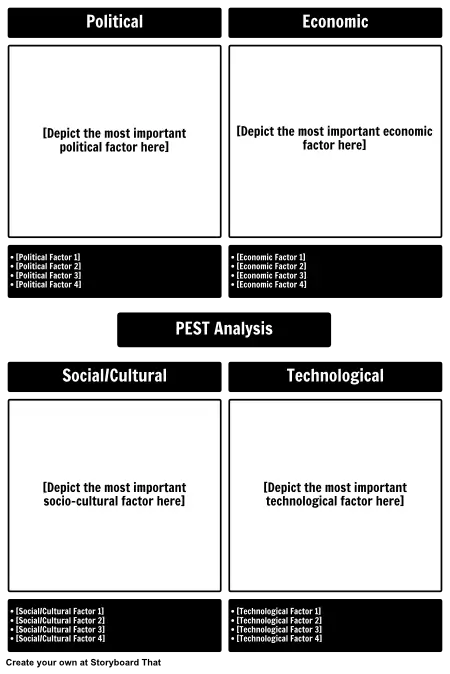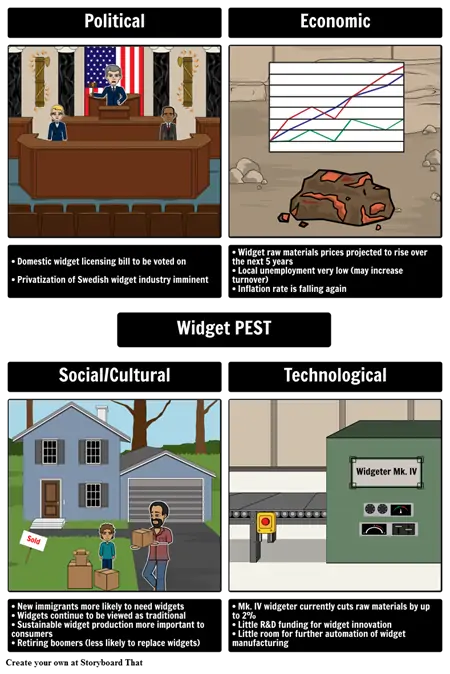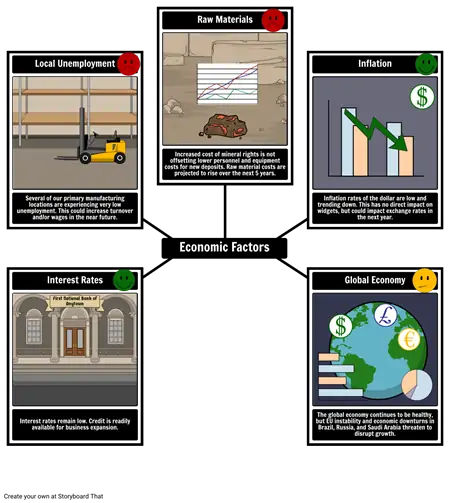What Does PEST Stand For?

Like a SWOT analysis, PEST contains four components: Political, Economic, Social/Cultural, and Technological. These four categories describe the big picture of where the business is situated, usually on a national or regional level. It is especially important to consider long term trends in a PEST analysis, as they may be more apparent in the world at large before their effects are felt on particular industries.
When preparing for the future, companies engage in strategic planning. This process looks at factors both inside and outside the company, and frequently employs a SWOT analysis, or similar framework, to organize the information generated. Strategic planning that examines external factors is called environmental scanning.
PEST analysis is a cornerstone of environmental scanning. Like Porter’s Five Forces, a PEST analysis looks outside the organization to the surrounding environment. However, unlike the Five Forces, which concentrate on the industry which surrounds a company, a PEST analysis looks at the large-scale (macro) environment outside of the industry. Just like the Five Forces, PEST corresponds to the Opportunities and Threats in SWOT.
| P | Political | Political doesn’t refer to just elections, but the broader influence of government on the business environment. This includes everything from labeling requirements to the risk of military invasion. Existing and forthcoming legislation, especially regarding taxation, wages, or intellectual property, can have a significant impact on business practices. For many analyses, “political” also covers a foreign country’s approach to rule of law, property rights, and corruption. |
|---|---|---|
| E | Economic | Economic considerations are primarily oriented to macroeconomics. While a SWOT may examine microeconomics questions like elasticity or efficiency, the role of PEST is to take a wider view of the economic environment. Credit availability, unemployment levels, and the overall health of the economy may not always seem directly relevant to a particular business, but they shape the climate in which all businesses operate. |
| S | Social / Cultural | Social and Cultural factors range from highly quantifiable elements like demographics, to less easily measured points like environmental consciousness or the effect of religious beliefs. Educational attainment, generational attitudes, community health, and social mobility are all socio-cultural aspects of the business environment. While they may be most apparent when considering international projects, these considerations can change dramatically between regions, cities, or even neighborhoods. |
| T | Technological | Technological innovations and changes drive nearly every industry. A thorough PEST analysis examines not only the current level of relevant technologies, but also the focus of research, recent prototypes, and upcoming obsolescence. Amenability to automation, diffusion of innovation, and infrastructure changes up and down the chain of production are all worthwhile considerations in this category. |

PEST analysis can be expanded with more granular categories, such as the Legal (SPELT), Ecological (PESTLE), Ethical (STEEPLE), Demographic (STEEPLED), or Intercultural (SPELIT). Normally these would be subsumed into one of the four PEST categories, but for businesses where these specific factors will have a particularly strong impact, it can be useful to separate them out.
How to Perform a PEST Analysis
To start a PEST analysis, brainstorm for a while, then select the three or four factors from each category that are most likely to drive or change your business. When you’ve isolated these primary concerns, illustrate the most significant. For each category, you can use a spider map to organize your brainstorming effort, or to present further detail in your analysis.
Don’t try to be exhaustive in listing factors under each category, there is always another item that can be added. Instead, remember that the PEST analysis is a tool for understanding how the broader environment affects your plans. When you’ve finished, consider incorporating the factors you’ve identified as either threats or opportunities in a SWOT analysis.
When to Use PEST
PEST is a valuable component of environmental scanning, so there is no wrong time to do it. Any new business should survey the terrain before jumping into a new undertaking. Even stable and successful businesses can benefit from watching out for trends in the business environment. In short, anyone who is doing a SWOT analysis, can incorporate a PEST analysis into that process. Whether you are an entrepreneur or part of a corporate team, a PEST analysis will better prepare you for the threats and opportunities you will face now and in the future.

How Tos about PEST Analysis
How can teachers help students relate PEST analysis to real-world issues?
Connect classroom learning to current events by asking students to identify and discuss how political, economic, social, and technological factors influence local or global news stories. This makes the abstract framework more meaningful and relevant for students.
Guide students to brainstorm examples for each PEST category.
Encourage creativity by having students list factors in each PEST category that affect a business, community, or school. Use group discussions or visual organizers like spider maps to spark ideas.
Organize a classroom debate on a business decision using PEST analysis.
Promote critical thinking by assigning students roles to represent different PEST factors and debate how they impact a proposed business move. This deepens understanding and engagement.
Relate PEST analysis to careers students know.
Make learning personal by having students research how PEST factors affect jobs in their community or industries they’re interested in. This shows the real-life value of strategic planning skills.
Build an interactive bulletin board for tracking PEST trends.
Foster ongoing engagement by creating a space where students can post news, data, or examples related to each PEST category. Update regularly to keep the analysis fresh and relevant.
Frequently Asked Questions about PEST Analysis
What does PEST stand for in business analysis?
PEST stands for Political, Economic, Social/Cultural, and Technological. These four categories help businesses analyze the external environment to identify trends, opportunities, and threats.
How do you perform a PEST analysis step by step?
To perform a PEST analysis, brainstorm external factors in each category, select the most impactful ones, and organize them using a spider map or table. Focus on identifying how these factors could influence your business's opportunities or threats.
Why is a PEST analysis important for strategic planning?
A PEST analysis is important because it helps businesses anticipate long-term trends and changes in the macro environment, allowing for better strategic decisions and risk management.
What are examples of factors in each PEST category?
Examples include Political: tax laws, regulations; Economic: unemployment rates, credit availability; Social/Cultural: demographics, social mobility; Technological: automation, innovation trends.
When should a company use PEST analysis?
A company should use PEST analysis during strategic planning, before launching new initiatives, or to monitor ongoing trends in the business environment. It is beneficial for startups and established businesses alike.
© 2025 - Clever Prototypes, LLC - All rights reserved.
StoryboardThat is a trademark of Clever Prototypes, LLC, and Registered in U.S. Patent and Trademark Office


